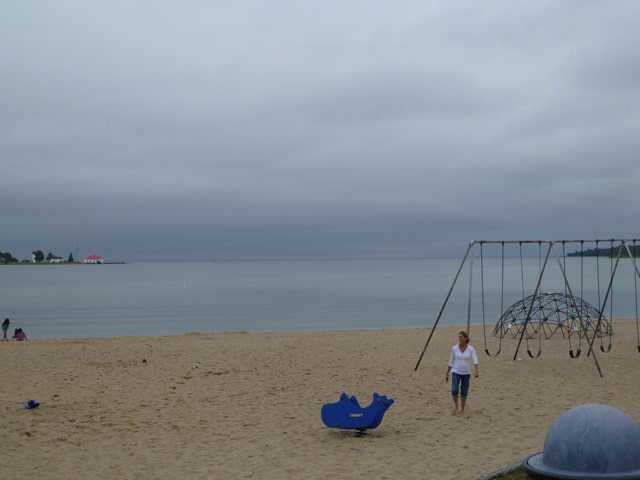
By Jane Beathard




As Don Cole tells it, Beaver Island is its own country.
The lifelong resident of Lake Michigan’s biggest island said locals once lived by their own laws and kept their distance from authorities in the rest of Michigan, as well as those in nearby Wisconsin and Ontario.
Cole descends from a long line of Beaver Islanders and loves to recount the history and lore of his home — one of the most remote places in the eastern United States.
He said in the old days, residents kept the peace without the benefit of badges or guns. Organized law enforcement was 32 water miles away on the Michigan mainland. And some rules were overlooked.
For example, some islanders avoided registering their motor vehicles with the state.
But when troopers came to call via ferry from Charlevoix, they found unlicensed vehicles had all disappeared into garages, barns and the island’s dense woodlands.
That’s because two horns sounded by the ferry captain warned residents in advance when “the law” was on board, Cole said with a laugh.
Lesser known and traveled than onshore vacation hot spots of Petoskey, Charlevoix and Traverse City, the island is an outdoor enthusiast’s delight with biking and birding trails, fishing lakes, boat rentals and public hunting grounds.
A two-hour ferry ride via the Beaver Island Boat Company lands visitors in the harbor village of St. James.
A ferry carries people, cars and supplies between the island and Charlevoix once daily from May to October. Two commercial airlines offer the only regular commute in winter.
Ninety-minute and three-hour guided tours of the 16-mile by eight-mile island are available through the boat company. The longer tour encompasses not only the area around St. James, but also public recreation areas on the island’s south side.
Tour guide Ruthie Gregg is another part-time resident with deep roots in Beaver Island soil. Like Cole, she loves to talk history.
She said Beaver Island is part of an archipelago that was once the center of America’s commercial fishing industry. A small museum in St. James recounts those years in pictures and antique fishing gear.
French fur trappers were the first to discover Beaver Island in the 1700s. They named the island for its shape, which resembles a beaver pelt.
An offshoot band of Mormons under the leadership of James Strang arrived in the mid 1800s. Strang declared himself “king” and ruled his Strangites with an iron fist and flailing bullwhip.
A museum and Mormon print shop in St. James remind modern visitors of those royal years. The village itself is named for Strang, as is the paved King’s Highway that bisects the island.
Two disgruntled followers murdered Strang in 1856 with an apparent “wink” from the U.S. military. Remaining Strangites were eventually driven off the island to a town in Wisconsin where their descendants remain today.
Beginning in the 1850s, waves of Irish immigrants from the Isle of Arranmore found their way to Beaver Island. They spoke Gaelic and a hint of their brogue still flits through the speech of Cole and other descendants.
The Irish flourished. They fished the surrounding lake waters and timbered Beaver Island’s forests. Their strong culture remains evident in the names of roads and natural features across the island.
Commercial fishing and timbering died off in the mid 1900s. And some islanders moved to more profitable jobs on the mainland.
Tourists and summertime residents were the latest to settle on Beaver Island. Beginning about 30 years ago, they became its chief industry and revenue source.
Vacation homes now sprout in the woods – along with a few hotels and B&Bs. St. James is home to a snack shop, grocery, pub and at least one upscale restaurant. A handful of galleries sell local crafts and artwork.
During the summer, the resident population of 500 swells to several thousand. They include prominent Chicago businessmen, as well as ordinary folks seeking solitude and a chance to live close to nature, Gregg said.
Information on activities and places to stay is available through the Beaver Island Chamber of Commerce at www.beaverisland.org.
JANE BEATHARD
Jane recently retired as a staff writer for The Madison Press in London, and is the retired media relations manager of the Ohio Department of Natural Resources.
ID, 'source', true); $sourcelink = get_post_meta($post->ID, 'sourcelink', true); $sourcestring = '' . __('SOURCE','gabfire') . ''; if ($sourcelink != '') { echo "
$sourcestring: $source
"; } elseif ($source != '') { echo "$sourcestring: $source
"; } // Display pagination $args = array( 'before' => '' . __('Pages:','gabfire'), 'after' => '
', 'link_before' => '', 'link_after' => '', 'next_or_number' => 'number', 'nextpagelink' => __('Next page', 'gabfire'), 'previouspagelink' => __('Previous page', 'gabfire'), 'pagelink' => '%', 'echo' => 1 ); wp_link_pages($args); // Display edit post link to site admin edit_post_link(__('Edit','gabfire'),'','
'); // Post Widget gab_dynamic_sidebar('PostWidget'); ?>